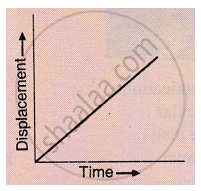Advertisements
Advertisements
प्रश्न
A body starts from rest and acquires a velocity 10 m s-1 in 2 s. Find the acceleration.
उत्तर
Here, final velocity = 10 m/s
Initial velocity = 0 m/s
Time taken = 2s
Acceleration = (Final Velocity - Initial Velocity)/time
= (10/2) ms-2
= 5 ms-2
APPEARS IN
संबंधित प्रश्न
Which of the two can be zero under certain conditions : average speed of a moving body or average velocity of a moving body ?
Fill in the following blank with a suitable word:
Acceleration is the rate of change of ______ It is measured in ______
What conclusion can you draw about the velocity of a body from the displacement-time graph shown below :

Explain why, the motion of a body which is moving with constant speed in a circular path is said to be accelerated.
Find the initial velocity of a car which is stopped in 10 seconds by applying brakes. The retardation due to brakes is 2.5 m/s2.
A freely falling object travels 4.9 m in 1st second, 14.7 m in 2 nd second, 24.5 m in 3rd second, and so on. This data shows that the motion of a freely falling object is a case of :
When is the negative acceleration?
Multiple choice Question. Select the correct option.
A body dropped from the top of a tower reaches the ground in 4s. Height of the tower is
How can you find the following?
Acceleration from velocity – time graph.
The velocity-time graph (Fig. 8.5) shows the motion of a cyclist. Find (i) its acceleration (ii) its velocity and (iii) the distance covered by the cyclist in 15 seconds.

